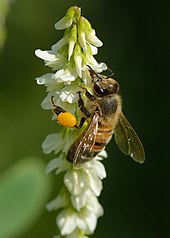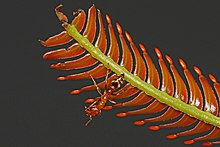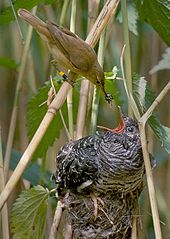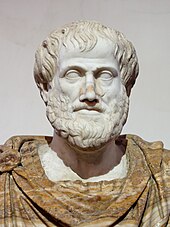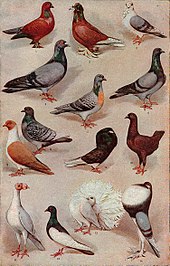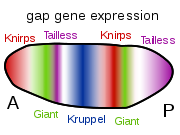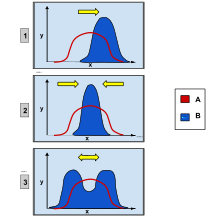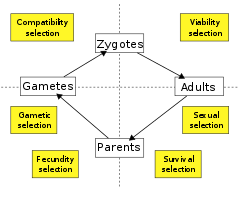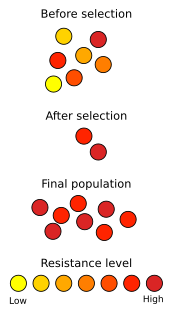From Wikipedia, the free encyclopedia
Modern biology began in the nineteenth century with
Charles Darwin's work on evolution by natural selection.
Natural selection is the differential survival and reproduction of individuals due to differences in
phenotype. It is a key mechanism of
evolution, the change in the
heritable traits characteristic of a
population over generations.
Charles Darwin popularised the term "natural selection", contrasting it with
artificial selection, which is intentional, whereas natural selection is not.
Variation exists within all populations of
organisms. This occurs partly because random
mutations arise in the
genome of an individual organism, and
offspring
can inherit such mutations. Throughout the lives of the individuals,
their genomes interact with their environments to cause variations in
traits. The environment of a genome includes the molecular biology in
the
cell, other cells, other individuals, populations,
species,
as well as the abiotic environment. Because individuals with certain
variants of the trait tend to survive and reproduce more than
individuals with other, less successful, variants, the population
evolves. Other factors affecting reproductive success include
sexual selection (now often included in natural selection) and
fecundity selection.
Natural selection acts on the phenotype, the characteristics of the
organism which actually interact with the environment, but the
genetic (heritable) basis of any phenotype that gives that phenotype a reproductive advantage may become
more common in a population. Over time, this process can result in populations that specialise for particular
ecological niches (
microevolution) and may eventually result in
speciation (the emergence of new species,
macroevolution). In other words, natural selection is a key process in the evolution of a population.
Natural selection is a cornerstone of modern
biology. The concept, published by Darwin and
Alfred Russel Wallace in a
joint presentation of papers in 1858, was elaborated in Darwin's influential 1859 book
On the Origin of Species by Means of Natural Selection, or the Preservation of Favoured Races in the Struggle for Life.
He described natural selection as analogous to artificial selection, a
process by which animals and plants with traits considered desirable by
human breeders are systematically favoured for reproduction. The concept
of natural selection originally developed in the absence of a valid
theory of heredity; at the time of Darwin's writing, science had yet to
develop modern theories of genetics. The union of traditional
Darwinian evolution with subsequent discoveries in
classical genetics formed the
modern synthesis of the mid-20th century. The addition of
molecular genetics has led to
evolutionary developmental biology, which explains evolution at the molecular level. While
genotypes can slowly change by random
genetic drift, natural selection remains the primary explanation for
adaptive evolution.
Historical development
Pre-Darwinian theories
Aristotle considered whether different forms could have appeared, only the useful ones surviving.
Several philosophers of the
classical era, including
Empedocles[1] and his intellectual successor, the
Roman poet
Lucretius,
[2]
expressed the idea that nature produces a huge variety of creatures,
randomly, and that only those creatures that manage to provide for
themselves and reproduce successfully persist. Empedocles' idea that
organisms arose entirely by the incidental workings of causes such as
heat and cold was criticised by
Aristotle in Book II of
Physics.
[3] He posited natural
teleology in its place, and believed that form was achieved for a purpose, citing the regularity of heredity in species as proof.
[4][5] Nevertheless, he accepted
in his biology that new types of animals,
monstrosities (τερας), can occur in very rare instances (
Generation of Animals, Book IV).
[6] As quoted in Darwin's 1872 edition of
The Origin of Species,
Aristotle considered whether different forms (e.g., of teeth) might
have appeared accidentally, but only the useful forms survived:
So what hinders the different parts [of the body] from having this
merely accidental relation in nature? as the teeth, for example, grow by
necessity, the front ones sharp, adapted for dividing, and the grinders
flat, and serviceable for masticating the food; since they were not
made for the sake of this, but it was the result of accident. And in
like manner as to the other parts in which there appears to exist an
adaptation to an end. Wheresoever, therefore, all things together (that
is all the parts of one whole) happened like as if they were made for
the sake of something, these were preserved, having been appropriately
constituted by an internal spontaneity, and whatsoever things were not
thus constituted, perished, and still perish.
—
Aristotle, Physics, Book II, Chapter 8[7]
But Aristotle rejected this possibility in the next paragraph, making
clear that he is talking about the development of animals as embryos
with the phrase "either invariably or normally come about", not the
origin of species:
... Yet it is impossible that this should be the true view. For teeth
and all other natural things either invariably or normally come about
in a given way; but of not one of the results of chance or spontaneity
is this true. We do not ascribe to chance or mere coincidence the
frequency of rain in winter, but frequent rain in summer we do; nor heat
in the dog-days, but only if we have it in winter. If then, it is
agreed that things are either the result of coincidence or for an end,
and these cannot be the result of coincidence or spontaneity, it follows
that they must be for an end; and that such things are all due to
nature even the champions of the theory which is before us would agree.
Therefore action for an end is present in things which come to be and
are by nature.
—
Aristotle, Physics, Book II, Chapter 8[8]
The
struggle for existence was later described by the
Islamic writer
Al-Jahiz in the 9th century.
[9][10][11]
The classical arguments were reintroduced in the 18th century by
Pierre Louis Maupertuis[12] and others, including Darwin's grandfather,
Erasmus Darwin.
Until the early 19th century, the
prevailing view in
Western societies was that differences between individuals of a species were uninteresting departures from their
Platonic ideals (or
typus) of
created kinds. However, the theory of
uniformitarianism
in geology promoted the idea that simple, weak forces could act
continuously over long periods of time to produce radical changes in the
Earth's landscape. The success of this theory raised awareness of the vast scale of
geological time
and made plausible the idea that tiny, virtually imperceptible changes
in successive generations could produce consequences on the scale of
differences between species.
[13]
The early 19th-century zoologist
Jean-Baptiste Lamarck suggested the
inheritance of acquired characteristics
as a mechanism for evolutionary change; adaptive traits acquired by an
organism during its lifetime could be inherited by that organism's
progeny, eventually causing
transmutation of species.
[14] This theory,
Lamarckism, was an influence on the Soviet biologist
Trofim Lysenko's antagonism to mainstream genetic theory as late as the mid 20th century.
[15]
Between 1835 and 1837, the zoologist
Edward Blyth
worked on the area of variation, artificial selection, and how a
similar process occurs in nature. Darwin acknowledged Blyth's ideas in
the first chapter on variation of
On the Origin of Species.
[16]
Darwin's theory
In 1859, Charles Darwin set out his theory of evolution by natural selection as an explanation for
adaptation
and speciation. He defined natural selection as the "principle by which
each slight variation [of a trait], if useful, is preserved".
[17]
The concept was simple but powerful: individuals best adapted to their
environments are more likely to survive and reproduce. As long as there
is some variation between them and that variation is
heritable,
there will be an inevitable selection of individuals with the most
advantageous variations. If the variations are heritable, then
differential reproductive success leads to a progressive evolution of
particular
populations of a species, and populations that evolve to be sufficiently different eventually become different species.
[18][19]
Darwin's ideas were inspired by the observations that he had made on the
second voyage of HMS Beagle (1831–1836), and by the work of a political economist,
Thomas Robert Malthus, who, in
An Essay on the Principle of Population (1798), noted that population (if unchecked)
increases exponentially, whereas the food supply grows only
arithmetically; thus, inevitable limitations of resources would have demographic implications, leading to a "struggle for existence".
[20] When Darwin read Malthus in 1838 he was already primed by his work as a
naturalist
to appreciate the "struggle for existence" in nature. It struck him
that as population outgrew resources, "favourable variations would tend
to be preserved, and unfavourable ones to be destroyed. The result of
this would be the formation of new species."
[21] Darwin wrote:
If during the long course of ages and under varying conditions of
life, organic beings vary at all in the several parts of their
organisation, and I think this cannot be disputed; if there be, owing to
the high geometrical powers of increase of each species, at some age,
season, or year, a severe struggle for life, and this certainly cannot
be disputed; then, considering the infinite complexity of the relations
of all organic beings to each other and to their conditions of
existence, causing an infinite diversity in structure, constitution, and
habits, to be advantageous to them, I think it would be a most
extraordinary fact if no variation ever had occurred useful to each
being's own welfare, in the same way as so many variations have occurred
useful to man. But if variations useful to any organic being do occur,
assuredly individuals thus characterised will have the best chance of
being preserved in the struggle for life; and from the strong principle
of inheritance they will tend to produce offspring similarly
characterised. This principle of preservation, I have called, for the
sake of brevity, Natural Selection.
Once he had his theory, Darwin was meticulous about gathering and
refining evidence before making his idea public. He was in the process
of writing his "big book" to present his research when the naturalist
Alfred Russel Wallace independently conceived of the principle and described it in an essay he sent to Darwin to forward to
Charles Lyell. Lyell and
Joseph Dalton Hooker decided to present his essay together with unpublished writings that Darwin had sent to fellow naturalists, and
On the Tendency of Species to form Varieties; and on the Perpetuation of Varieties and Species by Natural Means of Selection was read to the
Linnean Society of London announcing co-discovery of the principle in July 1858.
[23] Darwin published a detailed account of his evidence and conclusions in
On the Origin of Species in 1859. In the 3rd edition of 1861 Darwin acknowledged that others—like
William Charles Wells in 1813, and
Patrick Matthew in 1831—had proposed similar ideas, but had neither developed them nor presented them in notable scientific publications.
[24]
Darwin thought of natural selection by analogy to how farmers select crops or livestock for breeding, which he called "
artificial selection";
in his early manuscripts he referred to a "Nature" which would do the
selection. At the time, other mechanisms of evolution such as evolution
by genetic drift were not yet explicitly formulated, and Darwin believed
that selection was likely only part of the story: "I am convinced that
Natural Selection has been the main but not exclusive means of
modification."
[25]
In a letter to Charles Lyell in September 1860, Darwin regretted the
use of the term "Natural Selection", preferring the term "Natural
Preservation".
[26]
For Darwin and his contemporaries, natural selection was in essence
synonymous with evolution by natural selection. After the publication of
On the Origin of Species,
[27]
educated people generally accepted that evolution had occurred in some
form. However, natural selection remained controversial as a mechanism,
partly because it was perceived to be too weak to explain the range of
observed characteristics of living organisms, and partly because even
supporters of evolution balked at its "unguided" and non-
progressive nature,
[28] a response that has been characterised as the single most significant impediment to the idea's acceptance.
[29] However, some thinkers enthusiastically embraced natural selection; after reading Darwin,
Herbert Spencer introduced the phrase
survival of the fittest, which became a popular summary of the theory.
[30][31] The fifth edition of
On the Origin of Species
published in 1869 included Spencer's phrase as an alternative to
natural selection, with credit given: "But the expression often used by
Mr. Herbert Spencer of the Survival of the Fittest is more accurate, and
is sometimes equally convenient."
[32] Although the phrase is still often used by non-biologists, modern biologists avoid it because it is
tautological
if "fittest" is read to mean "functionally superior" and is applied to
individuals rather than considered as an averaged quantity over
populations.
[33]
The modern synthesis
Natural selection relies crucially on the idea of heredity, but developed before the basic concepts of
genetics. Although the
Moravian monk
Gregor Mendel, the father of modern genetics, was a contemporary of Darwin's, his work lay in obscurity, only being rediscovered in 1900.
[34] With the early 20th century integration of evolution with
Mendel's laws of inheritance, the so-called
modern synthesis, scientists generally came to accept natural selection.
[35][36] The synthesis grew from advances in different fields. Ronald Fisher developed the required mathematical language and wrote
The Genetical Theory of Natural Selection (1930).
[37] J. B. S. Haldane introduced the concept of the "cost" of natural selection.
[38][39] Sewall Wright elucidated the nature of selection and adaptation.
[40] In his book
Genetics and the Origin of Species (1937),
Theodosius Dobzhansky established the idea that mutation,
once seen as a rival to selection, actually supplied the raw material for natural selection by creating genetic diversity.
[41][42]
A second synthesis
Ernst Mayr recognised the key importance of
reproductive isolation for speciation in his
Systematics and the Origin of Species (1942).
[44] W. D. Hamilton conceived of
kin selection in 1964.
[45][46]
This synthesis cemented natural selection as the foundation of
evolutionary theory, where it remains today. A second synthesis was
brought about at the end of the 20th century by advances in
molecular genetics, creating the field of
evolutionary developmental biology ("evo-devo"), which seeks to explain the evolution of
form in terms of the
genetic regulatory programs
which control the development of the embryo at molecular level. Natural
selection is here understood to act on embryonic development to change
the morphology of the adult body.
[47][48][49][50]
Terminology
The term
natural selection
is most often defined to operate on heritable traits, because these
directly participate in evolution. However, natural selection is "blind"
in the sense that changes in phenotype can give a reproductive
advantage regardless of whether or not the trait is heritable. Following
Darwin's primary usage, the term is used to refer both to the
evolutionary consequence of blind selection and to its mechanisms.
[27][37][51][52]
It is sometimes helpful to explicitly distinguish between selection's
mechanisms and its effects; when this distinction is important,
scientists define "(phenotypic) natural selection" specifically as
"those mechanisms that contribute to the selection of individuals that
reproduce", without regard to whether the basis of the selection is
heritable.
[53][54][55] Traits that cause greater reproductive success of an organism are said to be
selected for, while those that reduce success are
selected against.
[56]
Mechanism
Heritable variation, differential reproduction
Natural variation occurs among the individuals of any population of
organisms. Some differences may improve an individual's chances of
surviving and reproducing such that its lifetime reproductive rate is
increased, which means that it leaves more offspring. If the traits that
give these individuals a reproductive advantage are also
heritable,
that is, passed from parent to offspring, then there will be
differential reproduction, that is, a slightly higher proportion of fast
rabbits or efficient algae in the next generation. Even if the
reproductive advantage is very slight, over many generations any
advantageous heritable trait becomes dominant in the population. In this
way the
natural environment of an organism "selects for" traits that confer a reproductive advantage, causing evolutionary change, as Darwin described.
[57] This gives the appearance of purpose, but in natural selection there is no intentional choice. Artificial selection is
purposive where natural selection is not, though
biologists often use teleological language to describe it.
[58]
The
peppered moth exists in both light and dark colours in Great Britain, but during the
industrial revolution, many of the trees on which the moths rested became blackened by
soot,
giving the dark-coloured moths an advantage in hiding from predators.
This gave dark-coloured moths a better chance of surviving to produce
dark-coloured offspring, and in just fifty years from the first dark
moth being caught, nearly all of the moths in industrial
Manchester were dark. The balance was reversed by the effect of the
Clean Air Act 1956, and the dark moths became rare again, demonstrating the influence of natural selection on
peppered moth evolution.
[59]
Fitness
The concept of fitness is central to natural selection. In broad
terms, individuals that are more "fit" have better potential for
survival, as in the well-known phrase "
survival of the fittest",
but the precise meaning of the term is much more subtle. Modern
evolutionary theory defines fitness not by how long an organism lives,
but by how successful it is at reproducing. If an organism lives half as
long as others of its species, but has twice as many offspring
surviving to adulthood, its genes become more common in the adult
population of the next generation. Though natural selection acts on
individuals, the effects of chance mean that fitness can only really be
defined "on average" for the individuals within a population. The
fitness of a particular genotype corresponds to the average effect on
all individuals with that genotype.
[60]
Competition
In biology, competition is an interaction between organisms in which
the fitness of one is lowered by the presence of another. This may be
because both rely on a
limited supply of a resource such as food, water, or
territory.
[61] Competition may be
within or
between species, and may be direct or indirect.
[62] Species less suited to compete should
in theory either adapt or die out,
since competition plays a powerful role in natural selection, but
according to the "room to roam" theory it may be less important than
expansion among larger
clades.
[62][63]
Competition is modelled by
r/K selection theory, which is based on
Robert MacArthur and
E. O. Wilson's work on
island biogeography.
[64] In this theory, selective pressures drive evolution in one of two stereotyped directions:
r- or
K-selection.
[65] These terms,
r and
K, can be illustrated in a
logistic model of
population dynamics:
[66]

where
r is the
growth rate of the population (
N), and
K is the
carrying capacity of its local environmental setting. Typically,
r-selected species exploit empty
niches, and produce many offspring, each with a relatively low
probability of surviving to adulthood. In contrast,
K-selected species are strong competitors in crowded niches, and
invest more heavily in much fewer offspring, each with a relatively high probability of surviving to adulthood.
[66]
Types of selection
Natural selection can act on any heritable
phenotypic trait,
[67] and selective pressure can be produced by any aspect of the environment, including sexual selection and
competition with members of the same or other species.
[68][69]
However, this does not imply that natural selection is always
directional and results in adaptive evolution; natural selection often
results in the maintenance of the status quo by eliminating less fit
variants.
[57]
Selection can be classified in several different ways, such as by its
effect on a trait, on genetic diversity, by the life cycle stage where
it acts, by the unit of selection, or by the resource being competed
for.
Selection has different effects on traits.
Stabilizing selection
acts to hold a trait at a stable optimum, and in the simplest case all
deviations from this optimum are selectively disadvantageous.
Directional selection favours extreme values of a trait. The uncommon
disruptive selection
also acts during transition periods when the current mode is
sub-optimal, but alters the trait in more than one direction. In
particular, if the trait is quantitative and
univariate then both higher and lower trait levels are favoured. Disruptive selection can be a precursor to
speciation.
[57]
Alternatively, selection can be divided according to its effect on
genetic diversity.
Purifying or negative selection acts to remove genetic variation from the population (and is opposed by
de novo mutation, which introduces new variation.
[70][71] In contrast,
balancing selection acts to maintain genetic variation in a population, even in the absence of
de novo mutation, by negative
frequency-dependent selection. One mechanism for this is
heterozygote advantage,
where individuals with two different alleles have a selective advantage
over individuals with just one allele. The polymorphism at the human
ABO blood group locus has been explained in this way.
[72]
Another option is to classify selection by the
life cycle stage at which it acts. Some biologists recognise just two types:
viability (or survival) selection,
which acts to increase an organism's probability of survival, and
fecundity (or fertility or reproductive) selection, which acts to
increase the rate of reproduction, given survival. Others split the life
cycle into further components of selection. Thus viability and survival
selection may be defined separately and respectively as acting to
improve the probability of survival before and after reproductive age is
reached, while fecundity selection may be split into additional
sub-components including sexual selection, gametic selection, acting on
gamete survival, and compatibility selection, acting on
zygote formation.
[73]
Selection can also be classified by the level or
unit of selection.
Individual selection acts on the individual, in the sense that
adaptations are "for" the benefit of the individual, and result from
selection among individuals.
Gene selection acts directly at the level of the gene. In
kin selection and
intragenomic conflict, gene-level selection provides a more apt explanation of the underlying process.
Group selection,
if it occurs, acts on groups of organisms, on the assumption that
groups replicate and mutate in an analogous way to genes and
individuals. There is an ongoing debate over the degree to which group
selection occurs in nature.
[74]
Finally, selection can be classified according to the
resource
being competed for. Sexual selection results from competition for
mates. Sexual selection typically proceeds via fecundity selection,
sometimes at the expense of viability.
Ecological selection is natural selection via any means other than sexual selection, such as kin selection, competition, and
infanticide.
Following Darwin, natural selection is sometimes defined as ecological
selection, in which case sexual selection is considered a separate
mechanism.
[75]
Sexual selection
Sexual selection as first articulated by Darwin (using the example of the
peacock's tail)
[76] refers specifically to competition for mates,
[78] which can be
intrasexual, between individuals of the same sex, that is male–male competition, or
intersexual, where one gender
chooses mates, most often with males displaying and females choosing.
[79] However, in some species, mate choice is primarily by males, as in some fishes of the family
Syngnathidae.
[80][81]
Phenotypic traits can be
displayed in one sex and desired in the other sex, causing a
positive feedback loop called a
Fisherian runaway, for example, the extravagant plumage of some male birds such as the peacock.
[77] An alternate theory proposed by the same
Ronald Fisher in 1930 is the
sexy son hypothesis,
that mothers want promiscuous sons to give them large numbers of
grandchildren and so choose promiscuous fathers for their children.
Aggression between members of the same sex is sometimes associated with
very distinctive features, such as the antlers of
stags, which are used in combat with other stags. More generally, intrasexual selection is often associated with
sexual dimorphism, including differences in body size between males and females of a species.
[79]
Natural selection in action
Selection in action:
resistance to antibiotics grows though the survival of individuals less affected by the antibiotic. Their offspring inherit the resistance.
Natural selection is seen in action in the development of
antibiotic resistance in
microorganisms. Since the discovery of
penicillin in 1928,
antibiotics
have been used to fight bacterial diseases. The widespread misuse of
antibiotics has selected for microbial resistance to antibiotics in
clinical use, to the point that the
methicillin-resistant Staphylococcus aureus
(MRSA) has been described as a "superbug" because of the threat it
poses to health and its relative invulnerability to existing drugs.
[82] Response strategies typically include the use of different, stronger antibiotics; however, new
strains of MRSA have recently emerged that are resistant even to these drugs.
[83] This is an
evolutionary arms race,
in which bacteria develop strains less susceptible to antibiotics,
while medical researchers attempt to develop new antibiotics that can
kill them. A similar situation occurs with
pesticide resistance
in plants and insects. Arms races are not necessarily induced by man; a
well-documented example involves the spread of a gene in the butterfly
Hypolimnas bolina suppressing male-killing activity by
Wolbachia bacteria parasites on the island of
Samoa, where the spread of the gene is known to have occurred over a period of just five years
[84][85]
Evolution by means of natural selection
A prerequisite for natural selection to result in adaptive evolution,
novel traits and speciation is the presence of heritable genetic
variation that results in fitness differences. Genetic variation is the
result of mutations,
genetic recombinations and alterations in the
karyotype (the number, shape, size and internal arrangement of the
chromosomes).
Any of these changes might have an effect that is highly advantageous
or highly disadvantageous, but large effects are rare. In the past, most
changes in the genetic material were considered neutral or close to
neutral because they occurred in
noncoding DNA or resulted in a
synonymous substitution. However, many mutations in non-coding DNA have deleterious effects.
[86][87]
Although both mutation rates and average fitness effects of mutations
are dependent on the organism, a majority of mutations in humans are
slightly deleterious.
[88]
Some mutations occur in
"toolkit" or regulatory genes.
Changes in these often have large effects on the phenotype of the
individual because they regulate the function of many other genes. Most,
but not all, mutations in regulatory genes result in non-viable
embryos. Some nonlethal regulatory mutations occur in
HOX genes in humans, which can result in a
cervical rib[89] or
polydactyly, an increase in the number of fingers or toes.
[90]
When such mutations result in a higher fitness, natural selection
favours these phenotypes and the novel trait spreads in the population.
Established traits are not immutable; traits that have high fitness in
one environmental context may be much less fit if environmental
conditions change. In the absence of natural selection to preserve such a
trait, it becomes more variable and deteriorate over time, possibly
resulting in a
vestigial manifestation of the trait, also called
evolutionary baggage.
In many circumstances, the apparently vestigial structure may retain a
limited functionality, or may be co-opted for other advantageous traits
in a phenomenon known as
preadaptation. A famous example of a vestigial structure, the eye of the
blind mole-rat, is believed to retain function in
photoperiod perception.
[91]
Speciation
Speciation requires a degree of
reproductive isolation—that is, a reduction in gene flow. However, it is intrinsic to the concept of a
species that
hybrids
are selected against, opposing the evolution of reproductive isolation,
a problem that was recognised by Darwin. The problem does not occur in
allopatric speciation with geographically separated populations, which can diverge with different sets of mutations.
E. B. Poulton
realized in 1903 that reproductive isolation could evolve through
divergence, if each lineage acquired a different, incompatible allele of
the same gene. Selection against the heterozygote would then directly
create reproductive isolation, leading to the
Bateson–Dobzhansky–Muller model, further elaborated by
H. Allen Orr[92] and
Sergey Gavrilets.
[93] With
reinforcement, however, natural selection can favor an increase in pre-zygotic isolation, influencing the process of speciation directly.
[94]
Genetic basis
Genotype and phenotype
Natural selection acts on an organism's phenotype, or physical
characteristics. Phenotype is determined by an organism's genetic
make-up (genotype) and the environment in which the organism lives. When
different organisms in a population possess different versions of a
gene for a certain trait, each of these versions is known as an
allele. It is this genetic variation that underlies differences in phenotype. An example is the
ABO blood type antigens in humans, where three alleles govern the phenotype.
[95]
Some traits are governed by only a single gene, but most traits are
influenced by the interactions of many genes. A variation in one of the
many genes that contributes to a trait may have only a small effect on
the phenotype; together, these genes can produce a continuum of possible
phenotypic values.
[96]
Directionality of selection
When some component of a trait is heritable, selection alters the
frequencies of the different alleles, or variants of the gene that
produces the variants of the trait. Selection can be divided into three
classes, on the basis of its effect on allele frequencies: directional,
stabilizing, and purifying selection.
[97]
Directional selection occurs when an allele has a greater fitness than
others, so that it increases in frequency, gaining an increasing share
in the population. This process can continue until the allele is
fixed and the entire population shares the fitter phenotype.
[98]
Far more common is stabilizing selection, which lowers the frequency of
alleles that have a deleterious effect on the phenotype – that is,
produce organisms of lower fitness. This process can continue until the
allele is eliminated from the population. Purifying selection
conserves functional genetic features, such as
protein-coding genes or
regulatory sequences, over time by selective pressure against deleterious variants.
[99]
Some forms of balancing selection do not result in fixation, but
maintain an allele at intermediate frequencies in a population. This can
occur in
diploid species (with pairs of chromosomes) when
heterozygous
individuals (with just one copy of the allele) have a higher fitness
than homozygous individuals (with two copies). This is called
heterozygote advantage or over-dominance, of which the best-known
example is the resistance to malaria in humans heterozygous for
sickle-cell anaemia. Maintenance of allelic variation can also occur through
disruptive or diversifying selection,
which favours genotypes that depart from the average in either
direction (that is, the opposite of over-dominance), and can result in a
bimodal distribution
of trait values. Finally, balancing selection can occur through
frequency-dependent selection, where the fitness of one particular
phenotype depends on the distribution of other phenotypes in the
population. The principles of
game theory
have been applied to understand the fitness distributions in these
situations, particularly in the study of kin selection and the evolution
of
reciprocal altruism.
[100][101]
Selection, genetic variation, and drift
A portion of all genetic variation is functionally neutral, producing
no phenotypic effect or significant difference in fitness.
Motoo Kimura's
neutral theory of molecular evolution by
genetic drift proposes that this variation accounts for a large fraction of observed genetic diversity.
[102] Neutral events can radically reduce genetic variation through
population bottlenecks.
[103] which among other things can cause the
founder effect in initially small new populations.
[104]
When genetic variation does not result in differences in fitness,
selection cannot directly affect the frequency of such variation. As a
result, the genetic variation at those sites is higher than at sites
where variation does influence fitness.
[97]
However, after a period with no new mutations, the genetic variation at
these sites is eliminated due to genetic drift. Natural selection
reduces genetic variation by eliminating maladapted individuals, and
consequently the mutations that caused the maladaptation. At the same
time, new mutations occur, resulting in a
mutation–selection balance.
The exact outcome of the two processes depends both on the rate at
which new mutations occur and on the strength of the natural selection,
which is a function of how unfavourable the mutation proves to be.
[105]
Genetic linkage occurs when the
loci
of two alleles are in close proximity on a chromosome. During the
formation of gametes, recombination reshuffles the alleles. The chance
that such a reshuffle occurs between two alleles is inversely related to
the distance between them.
Selective sweeps
occur when an allele becomes more common in a population as a result of
positive selection. As the prevalence of one allele increases, closely
linked alleles can also become more common by "
genetic hitchhiking",
whether they are neutral or even slightly deleterious. A strong
selective sweep results in a region of the genome where the positively
selected
haplotype
(the allele and its neighbours) are in essence the only ones that exist
in the population. Selective sweeps can be detected by measuring
linkage disequilibrium,
or whether a given haplotype is overrepresented in the population.
Since a selective sweep also results in selection of neighbouring
alleles, the presence of a block of strong linkage disequilibrium might
indicate a 'recent' selective sweep near the centre of the block.
[106]
Background selection
is the opposite of a selective sweep. If a specific site experiences
strong and persistent purifying selection, linked variation tends to be
weeded out along with it, producing a region in the genome of low
overall variability. Because background selection is a result of
deleterious new mutations, which can occur randomly in any haplotype, it
does not produce clear blocks of linkage disequilibrium, although with
low recombination it can still lead to slightly negative linkage
disequilibrium overall.
[107]
Impact
Darwin's ideas, along with those of
Adam Smith and
Karl Marx,
had a profound influence on 19th century thought, including his radical
claim that "elaborately constructed forms, so different from each
other, and dependent on each other in so complex a manner" evolved from
the simplest forms of life by a few simple principles.
[108]
This inspired some of Darwin's most ardent supporters—and provoked the
strongest opposition. Natural selection had the power, according to
Stephen Jay Gould,
to "dethrone some of the deepest and most traditional comforts of
Western thought", such as the belief that humans have a special place in
the world.
[109]
In the words of the philosopher
Daniel Dennett,
"Darwin's dangerous idea" of evolution by natural selection is a
"universal acid," which cannot be kept restricted to any vessel or
container, as it soon leaks out, working its way into ever-wider
surroundings.
[110] Thus, in the last decades, the concept of natural selection has spread from
evolutionary biology to other disciplines, including
evolutionary computation,
quantum Darwinism,
evolutionary economics,
evolutionary epistemology,
evolutionary psychology, and
cosmological natural selection. This unlimited applicability has been called
universal Darwinism.
[111]
Origin of life
How life originated from inorganic matter remains an unresolved
problem in biology. One prominent hypothesis is that life first appeared
in the form of short self-replicating RNA polymers.
[112] On this view, life may have come into existence when
RNA
chains first experienced the basic conditions, as conceived by Charles
Darwin, for natural selection to operate. These conditions are:
heritability,
variation of type, and competition for limited resources. The fitness of an early
RNA replicator would likely have been a function of adaptive capacities that were intrinsic (i.e., determined by the
nucleotide sequence) and the availability of resources.
[113][114]
The three primary adaptive capacities could logically have been: (1)
the capacity to replicate with moderate fidelity (giving rise to both
heritability and variation of type), (2) the capacity to avoid decay,
and (3) the capacity to acquire and process resources.
[113][114] These capacities would have been determined initially by the folded configurations (including those configurations with
ribozyme activity) of the RNA replicators that, in turn, would have been encoded in their individual nucleotide sequences.
[115]
Cell and molecular biology
In 1881, the embryologist
Wilhelm Roux published
Der Kampf der Theile im Organismus (
The Struggle of Parts in the Organism)
in which he suggested that the development of an organism results from a
Darwinian competition between the parts of the embryo, occurring at all
levels, from molecules to organs.
[116] In recent years, a modern version of this theory has been proposed by
Jean-Jacques Kupiec. According to this cellular Darwinism,
random variation
at the molecular level generates diversity in cell types whereas cell
interactions impose a characteristic order on the developing embryo.
[117]
Social and psychological theory
The social implications of the theory of evolution by natural selection also became the source of continuing controversy.
Friedrich Engels, a German
political philosopher and co-originator of the ideology of
communism,
wrote in 1872 that "Darwin did not know what a bitter satire he wrote
on mankind, and especially on his countrymen, when he showed that free
competition, the struggle for existence, which the economists celebrate
as the highest historical achievement, is the normal state of the
animal kingdom."
[118] Herbert Spencer and the eugenics advocate
Francis Galton's
interpretation of natural selection as necessarily progressive, leading
to supposed advances in intelligence and civilisation, became a
justification for
colonialism,
eugenics, and
social Darwinism. For example, in 1940,
Konrad Lorenz, in writings that he subsequently disowned, used the theory as a justification for policies of the
Nazi
state. He wrote "... selection for toughness, heroism, and social
utility ... must be accomplished by some human institution, if mankind,
in default of selective factors, is not to be ruined by
domestication-induced degeneracy. The racial idea as the basis of our
state has already accomplished much in this respect."
[119] Others have developed ideas that human societies and culture
evolve by mechanisms analogous to those that apply to evolution of species.
[120]
More recently, work among anthropologists and psychologists has led to the development of
sociobiology and later of evolutionary psychology, a field that attempts to explain features of
human psychology
in terms of adaptation to the ancestral environment. The most prominent
example of evolutionary psychology, notably advanced in the early work
of
Noam Chomsky and later by
Steven Pinker, is the hypothesis that the human brain has adapted to
acquire the
grammatical rules of
natural language.
[121] Other aspects of human behaviour and social structures, from specific cultural norms such as
incest avoidance to broader patterns such as
gender roles,
have been hypothesised to have similar origins as adaptations to the
early environment in which modern humans evolved. By analogy to the
action of natural selection on genes, the concept of
memes—"units
of cultural transmission," or culture's equivalents of genes undergoing
selection and recombination—has arisen, first described in this form by
Richard Dawkins in 1976
[122] and subsequently expanded upon by philosophers such as
Daniel Dennett as explanations for complex cultural activities, including human
consciousness.
[123]
Information and systems theory
In 1922,
Alfred J. Lotka
proposed that natural selection might be understood as a physical
principle that could be described in terms of the use of energy by a
system,
[124][125] a concept later developed by
Howard T. Odum as the
maximum power principle in
thermodynamics, whereby evolutionary systems with selective advantage maximise the rate of useful energy transformation.
[126]
The principles of natural selection have inspired a variety of computational techniques, such as "soft"
artificial life, that simulate selective processes and can be highly efficient in 'adapting' entities to an environment defined by a specified
fitness function.
[127] For example, a class of
heuristic optimisation algorithms known as
genetic algorithms, pioneered by
John Henry Holland in the 1970s and expanded upon by
David E. Goldberg,
[128] identify optimal solutions by simulated reproduction and mutation of a population of solutions defined by an initial
probability distribution.
[129] Such algorithms are particularly useful when applied to problems whose
energy landscape is very rough or has many local minima.
[130]
